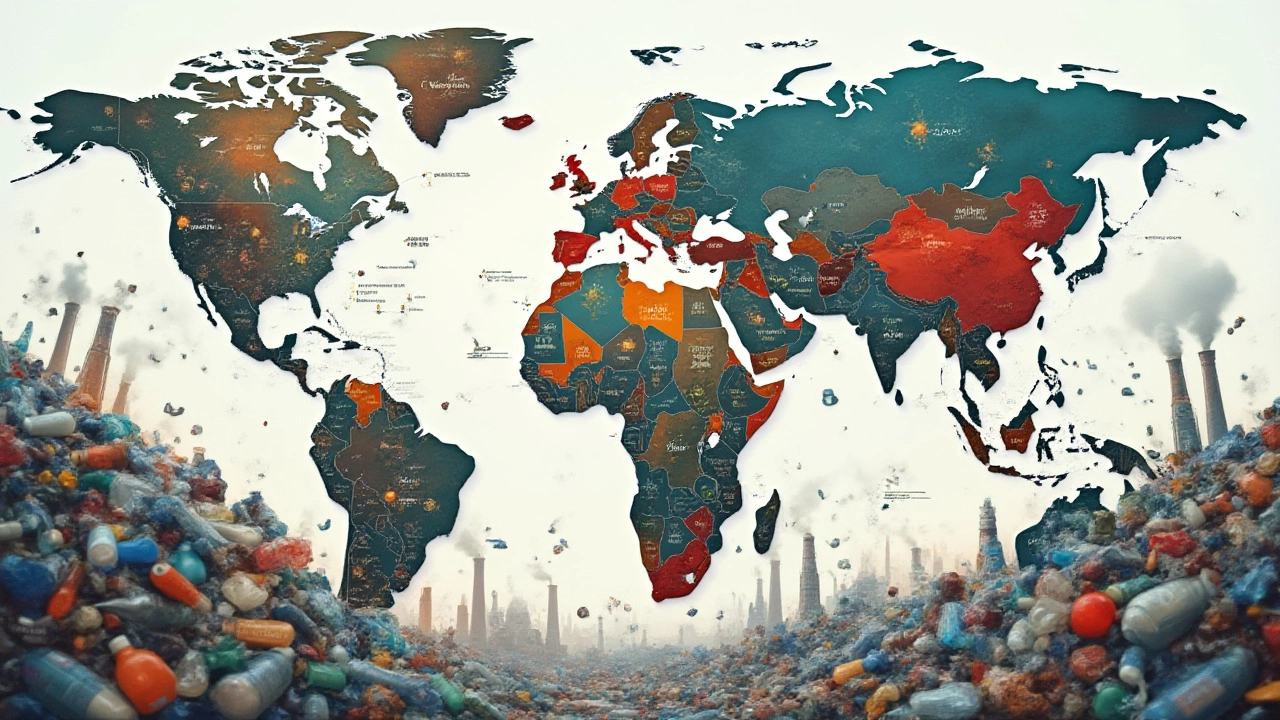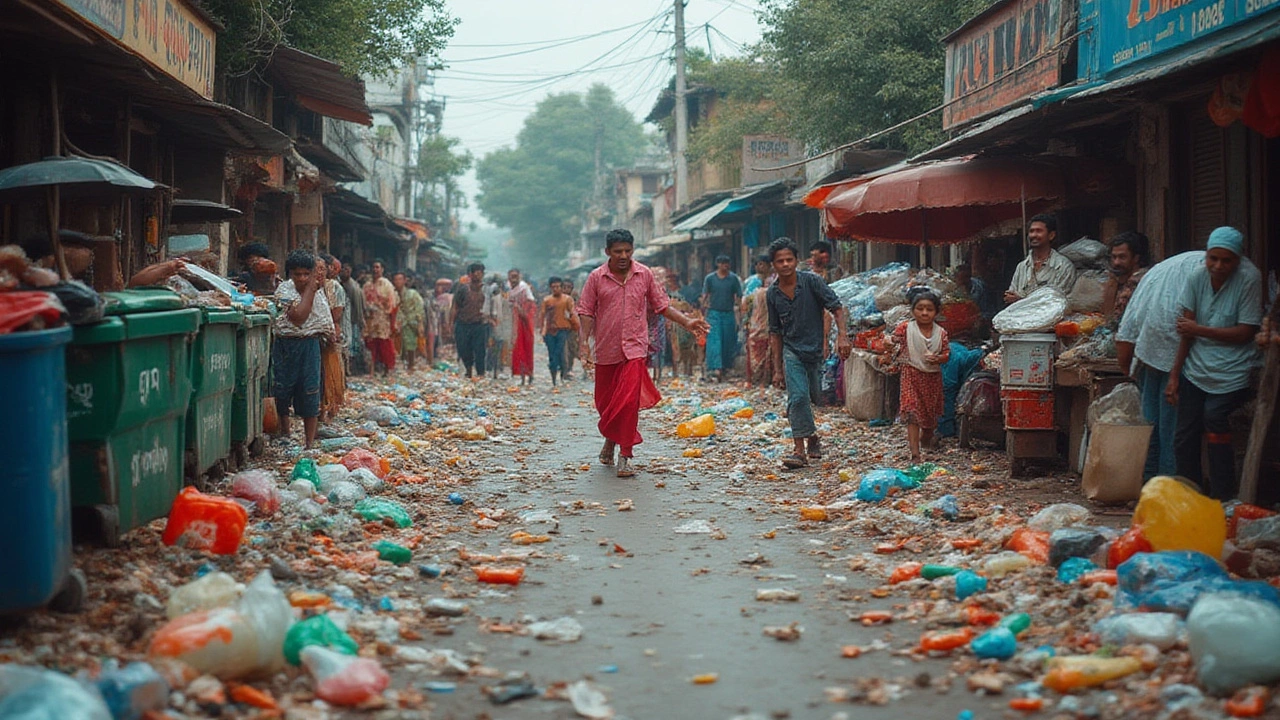 Jul, 15 2025
Jul, 15 2025
You know those plastic wrappers from snacks, water bottles, and grocery bags everywhere? They've stacked up so much that they're choking our planet. It sounds like sci-fi, but plastic waste is outpacing us—and there’s one country that absolutely towers over the rest as the biggest plastic polluter. Millions are feeling the pain in rivers, streets, and even food chains. It's not just about tossing that soda bottle in the blue bin. It’s the systems and habits we’ve let run wild from factories to living rooms. Think it’s someone else’s problem? Think again. If you’ve unwrapped a package this week, you’re already involved in this global mess.
The World’s Plastic Waste Giant: Who Tops the List?
When it comes to sheer volume, no country touches the United States in producing plastic waste. According to a 2021 report published in "Science Advances," the United States churned out an eye-watering 42 million metric tons of plastic waste in 2016 alone—a number that’s only crept higher each year. That’s about 130 kilograms per person, every single year. Pile it up, and you’re looking at enough plastic to cover Texas several times over. What really scorches the brain, though, is that the U.S. holds only about 4% of the world’s population but manages to create more plastic garbage than any other nation.
China used to be in the hot seat, but things changed after the country slammed the gates on imported waste with their "National Sword" policy in 2018. The U.S. could no longer ship its discarded plastics to China’s shores, leaving local landfills and incinerators to take the hit. While China still produces huge amounts of plastic—over 28 million tons per year as of 2024—the shift put the American plastic habit under a microscope. Other heavy hitters include India, Indonesia, and countries in the European Union, yet the per-person numbers put the U.S. in a league of its own.
It’s not just about total volume, either. The kicker is how much of the waste escapes proper management. While European countries tend to burn or recycle a larger share, the U.S. still leaks over 2.24 million metric tons of plastic into the environment yearly. Imagine entire lakes clogged with snack bags, shopping bags, and fishing nets, then multiply it by thousands—that’s the true scale of the problem. Meanwhile, developing countries like Indonesia and the Philippines grapple with huge leaks due to weak waste collection infrastructure. Still, if you’re hunting for the single plastic waste champ by sheer tonnage and impact, the U.S. has no close rival right now.
Why Is So Much Plastic Waste Being Produced?
The reasons behind America’s plastic problem—and the globe’s—start with the things you likely can’t avoid when you step outside: single-use plastics. From fast food drink lids to online shopping packaging, convenience culture drives enormous demand for cost-effective plastics. Most are used once, maybe twice, then tossed. And plastics aren’t just in packaging. They’re in clothes (polyester shirts, yoga pants), electronics, cars, and appliances. The more stuff we buy, especially through e-commerce, the more plastic surrounds us.
Industry also loves plastic for its durability, light weight, and ultra-cheap price. Petroleum giants, faced with competition in fuel markets, have invested billions in new "cracker" plants along the Gulf Coast to pump out even more polyethylene and polypropylene. In fact, disposable plastic production has gone up nearly 200 times since the early 1960s. Only a tiny fraction—less than 10% worldwide—ever gets recycled. Around 40% of all plastic globally is used just for packaging. That’s bananas, considering most packaging lasts minutes before hitting the trash.
But recycling is only part of the story. The U.S. recycling rate is below 9%, which means the vast majority of plastic either ends up in landfills (where it can linger for centuries) or escapes into waterways and our environment. Cities struggle to process certain types, especially flimsy films and mixed plastics. Internationally, lower-income nations have to cope with used plastic trade and weak garbage collection networks, leading to mountains of trash clogging rivers and coastlines. E-waste and the rise of fast fashion add hidden layers, since most blends and coatings are plastic-based. And let’s be honest: swapping a reusable cup for a paper one is only a dent if factories keep heavy pumping on their end.

The Ugly Truth: Where Does All That Plastic Go?
Here’s what usually happens: after a short stop in the trash can, most plastic tumbles into landfills, is incinerated, or—when things go really wrong—blows away into the wild. Of that staggering 42 million tons the U.S. ditches yearly, only about 2.9 million tons are actually recycled according to EPA figures from 2023. The rest? Some heads to "waste-to-energy" plants, releasing climate-warming gases in the process, and millions of tons wind up in rivers, lakes, and oceans.
Below the surface, microplastics—teensy bits that break off from tires, clothes, and bottles—are turning up everywhere, from Lake Michigan’s shores to the deepest Pacific trenches. Scientists in 2022 found these tiny shards in sea salt, drinking water, and even human blood. Sea creatures mistake them for food, and it comes right back up the food chain. The U.S. might be the global heavyweight, but the effects splash everywhere. For every plastic bag that drifts out of a bin in California or Massachusetts, there’s a sea turtle or bird thousands of miles away swallowing a headache it never signed up for.
The problem isn’t just global, it’s local too. Beaches from Miami to Oregon fill up after each big storm, while stormwater systems clog and rivers like the Mississippi ship thousands of tons downstream each season. Waste that doesn’t end up in the environment is burned: incinerators are concentrated in working-class and minority neighborhoods, raising big concerns with air pollution and health impacts. Nobody is untouched—if you live, shop, or eat almost anywhere in the world, you’re swimming in the consequences of plastic’s "miracle material" status.
Tackling the Problem: What Works and What Doesn’t
The plastic wave isn’t inevitable. Countries and cities are testing all kinds of interventions, with mixed results. In the EU, single-use plastic bans kicked off in 2021, targeting straws, cutlery, and those clamshell food containers. Certain cities in the U.S.—San Francisco, Seattle, and New York—have passed bag fees, foam bans, or restrictions that seriously cut down on visible litter. California approved legislation forcing companies to reduce packaging by 25% over ten years, with hefty penalties baked in for missing targets.
Recycling alone hasn’t delivered the knockout punch. It’s still too expensive to process many mixed or dirty plastics, and the market for recycled resin is shaky. That’s why new ideas are gaining traction: extended producer responsibility (EPR) laws, for instance, shift cleanup costs onto manufacturers, making them responsible for the afterlife of their products. Some U.S. states are pushing this agenda, but federal action is still slow. Brands like Coca-Cola, PepsiCo, and Unilever are rolling out refill stations and "loop" delivery systems in places like London and Paris, to see if waste-free shopping is doable at scale. Cities in Asia and Africa are investing in door-to-door collection and plastic-buyback schemes, aiming to prevent garbage from ever hitting rivers and seas.
But no solution beats cutting plastic off at the tap. Carry a reusable bag and bottle, pick products with minimal packaging, and support brands that offer refills and use recycled content. Push your local government to improve sorting and waste collection. If you have kids, look for school programs swapping single-use lunch items for reusables—schools are chunky sources of snack wrappers. Compostable alternatives look great, but only if your city has the infrastructure to handle them; otherwise, they go to the dump too. Voting matters, too: support politicians who make reducing plastic and holding big companies accountable a campaign priority.
Plastic pollution is the ultimate shared problem with simple starting points and mind-boggling complexity beneath the surface. No country—and no one—can dodge the everyday impacts. Most of all, plastic isn’t just an environmental fight: it’s about public health, cleaner neighborhoods, and a future where "convenience" stops costing the earth.